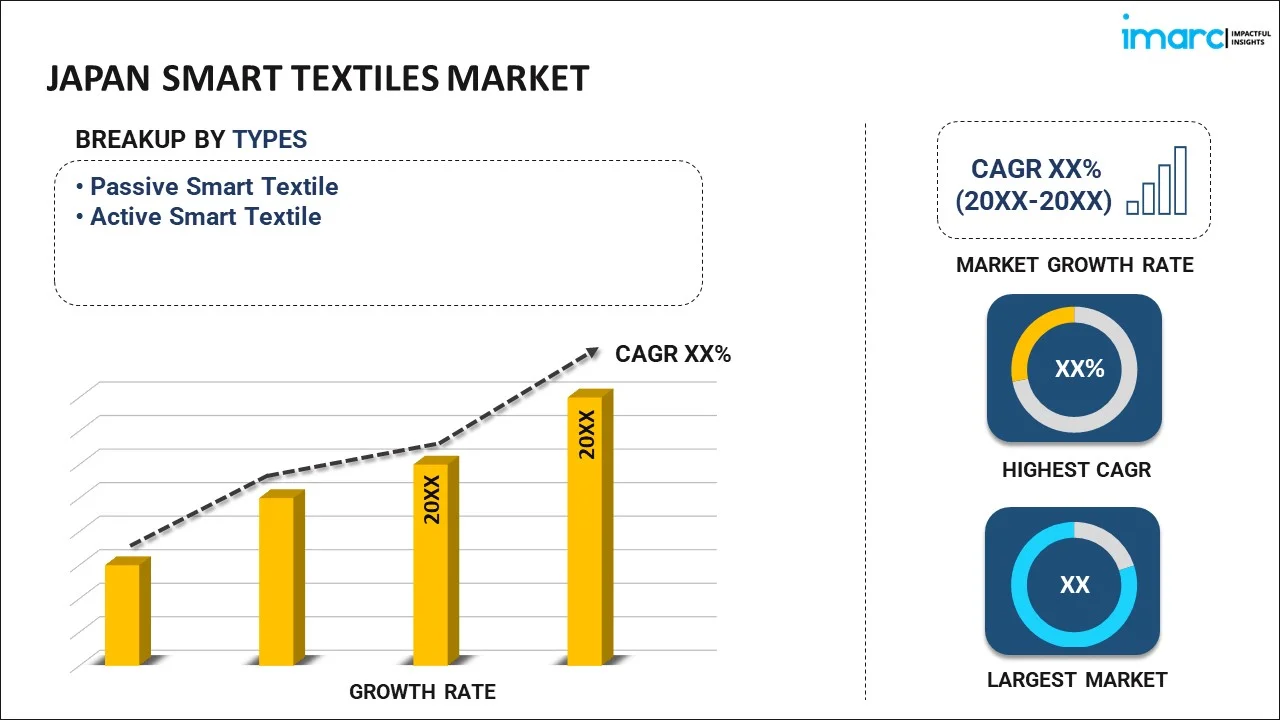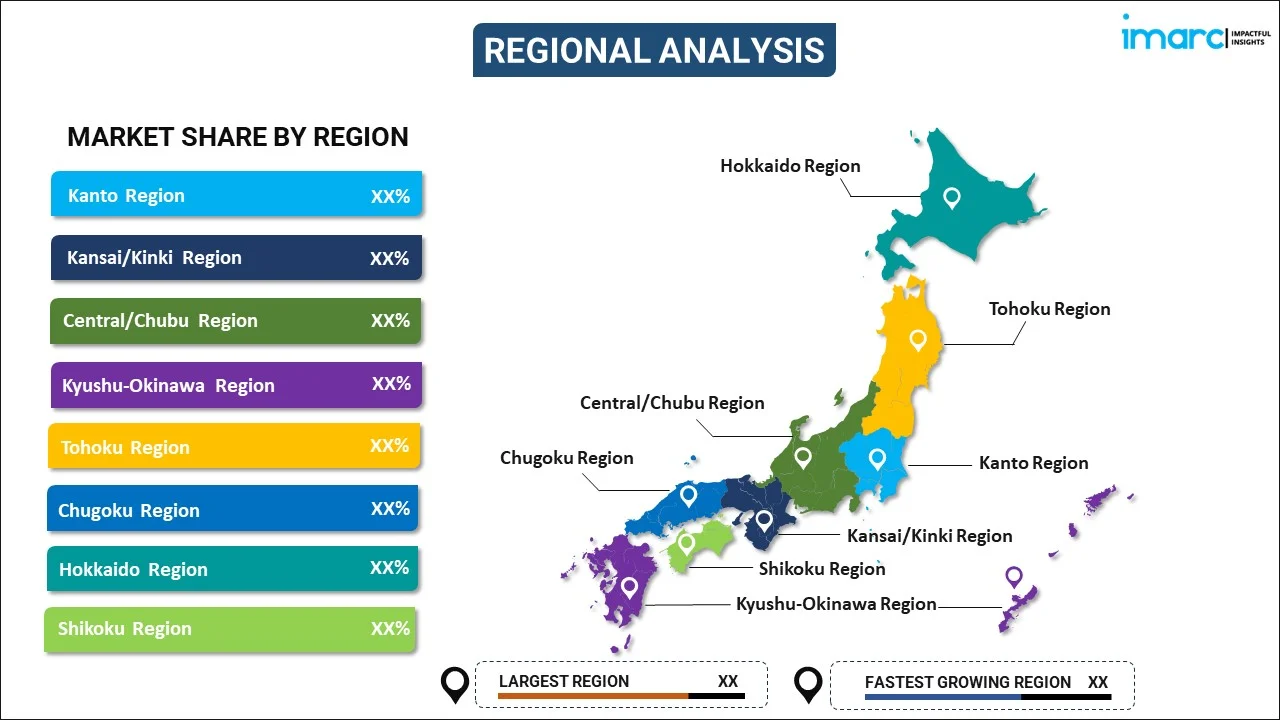
Japan Smart Textiles Market Report by Type (Passive Smart Textile, Active Smart Textile), Functionality (Sensing, Energy Harvesting, Luminescence and Aesthetics, Thermoelectricity, and Others), End-Use Sector (Military and Protection, Healthcare, Sports and Fitness, Fashion and Entertainment, Transportation, Architecture, and Others), and Region 2025-2033
Market Overview:
Japan smart textiles market size reached USD 250.9 Million in 2024. Looking forward, IMARC Group expects the market to reach USD 1,547.0 Million by 2033, exhibiting a growth rate (CAGR) of 20.5% during 2025-2033. The increasing demand for continuous health metric monitoring, the swift expansion of the Internet of Things (IoT), and the rising backing through grants and tax incentives are primary drivers fostering the market's growth.
|
Report Attribute
|
Key Statistics
|
|---|---|
|
Base Year
|
2024
|
|
Forecast Years
|
2025-2033
|
|
Historical Years
|
2019-2024
|
|
Market Size in 2024
|
USD 250.9 Million |
|
Market Forecast in 2033
|
USD 1,547.0 Million |
| Market Growth Rate 2025-2033 | 20.5% |
Smart textiles, also referred to as e-textiles, are fabrics that incorporate digital components such as sensors, microcontrollers, and conductive fibers. These textiles possess the capability to detect, respond to, and adapt to environmental conditions or stimuli originating from mechanical, thermal, or chemical sources. Unlike conventional fabrics, smart textiles offer interactive features and have the capacity to transmit data. They are finding increasing applications in various sectors, including healthcare, sports, military, and fashion. In the healthcare field, they can monitor vital signs and send alerts to medical professionals. In sports, they can record performance metrics. Military applications involve advanced camouflage and body armor equipped with integrated communication systems.
Japan Smart Textiles Market Trends:
The rising demand for smart textiles in the healthcare sector is a primary driver of market growth in Japan. With an aging population and an increase in chronic illnesses, there is a growing requirement for continuous monitoring of health parameters like heart rate, temperature, and blood pressure. Smart textiles provide a discreet and convenient solution to meet this need. Furthermore, the rapid expansion of the Internet of Things (IoT) is making a significant contribution to the growth of the smart textiles market. As IoT devices become more prevalent, there is a heightened demand for seamless integration between hardware and user experience. Additionally, consumer electronics and wearables have become integral parts of daily life, making the integration of smart textiles a natural progression. Governments and regulatory bodies are also recognizing the potential of smart textiles across various sectors, including healthcare, defense, and public safety. This recognition has led to increased support in the form of grants, tax incentives, and research funding for companies operating in the smart textiles industry. This regulatory backing has the potential to expedite research and development efforts, facilitate the growth of small startups, and encourage collaborations between textile manufacturers and technology firms, which in turn, will catalyze the regional market in the coming years.
Japan Smart Textiles Market Segmentation:
IMARC Group provides an analysis of the key trends in each segment of the market, along with forecasts at the country level for 2025-2033. Our report has categorized the market based on type, functionality, and end-use sector.
Type Insights:

- Passive Smart Textile
- Active Smart Textile
The report has provided a detailed breakup and analysis of the market based on the type. This includes passive smart textile and active smart textile.
Functionality Insights:
- Sensing
- Energy Harvesting
- Luminescence and Aesthetics
- Thermoelectricity
- Others
A detailed breakup and analysis of the market based on the functionality have also been provided in the report. This includes sensing, energy harvesting, luminescence and aesthetics, thermoelectricity, and others.
End-Use Sector Insights:
- Military and Protection
- Healthcare
- Sports and Fitness
- Fashion and Entertainment
- Transportation
- Architecture
- Others
The report has provided a detailed breakup and analysis of the market based on the end-use sector. This includes military and protection, healthcare, sports and fitness, fashion and entertainment, transportation, architecture, and others.
Regional Insights:

- Kanto Region
- Kansai/Kinki Region
- Central/ Chubu Region
- Kyushu-Okinawa Region
- Tohoku Region
- Chugoku Region
- Hokkaido Region
- Shikoku Region
The report has also provided a comprehensive analysis of all the major regional markets, which include Kanto Region, Kansai/Kinki Region, Central/ Chubu Region, Kyushu-Okinawa Region, Tohoku Region, Chugoku Region, Hokkaido Region, and Shikoku Region.
Competitive Landscape:
The market research report has also provided a comprehensive analysis of the competitive landscape. Competitive analysis such as market structure, key player positioning, top winning strategies, competitive dashboard, and company evaluation quadrant has been covered in the report. Also, detailed profiles of all major companies have been provided.
Japan Smart Textiles Market Report Coverage:
| Report Features | Details |
|---|---|
| Base Year of the Analysis | 2024 |
| Historical Period | 2019-2024 |
| Forecast Period | 2025-2033 |
| Units | Million USD |
| Scope of the Report | Exploration of Historical Trends and Market Outlook, Industry Catalysts and Challenges, Segment-Wise Historical and Future Market Assessment:
|
| Types Covered | Passive Smart Textile, Active Smart Textile |
| Functionalities Covered | Sensing, Energy Harvesting, Luminescence and Aesthetics, Thermoelectricity, Others |
| End-Use Sectors Covered | Military and Protection, Healthcare, Sports and Fitness, Fashion and Entertainment, Transportation, Architecture, Others |
| Regions Covered | Kanto Region, Kansai/Kinki Region, Central/ Chubu Region, Kyushu-Okinawa Region, Tohoku Region, Chugoku Region, Hokkaido Region, Shikoku Region |
| Customization Scope | 10% Free Customization |
| Post-Sale Analyst Support | 10-12 Weeks |
| Delivery Format | PDF and Excel through Email (We can also provide the editable version of the report in PPT/Word format on special request) |
Key Questions Answered in This Report:
- How has the Japan smart textiles market performed so far and how will it perform in the coming years?
- What has been the impact of COVID-19 on the Japan smart textiles market?
- What is the breakup of the Japan smart textiles market on the basis of type?
- What is the breakup of the Japan smart textiles market on the basis of functionality?
- What is the breakup of the Japan smart textiles market on the basis of end-use sector?
- What are the various stages in the value chain of the Japan smart textiles market?
- What are the key driving factors and challenges in the Japan smart textiles?
- What is the structure of the Japan smart textiles market and who are the key players?
- What is the degree of competition in the Japan smart textiles market?
Key Benefits for Stakeholders:
- IMARC’s industry report offers a comprehensive quantitative analysis of various market segments, historical and current market trends, market forecasts, and dynamics of the Japan smart textiles market from 2019-2033.
- The research report provides the latest information on the market drivers, challenges, and opportunities in the Japan smart textiles market.
- Porter's five forces analysis assist stakeholders in assessing the impact of new entrants, competitive rivalry, supplier power, buyer power, and the threat of substitution. It helps stakeholders to analyze the level of competition within the Japan smart textiles industry and its attractiveness.
- Competitive landscape allows stakeholders to understand their competitive environment and provides an insight into the current positions of key players in the market.
Need more help?
- Speak to our experienced analysts for insights on the current market scenarios.
- Include additional segments and countries to customize the report as per your requirement.
- Gain an unparalleled competitive advantage in your domain by understanding how to utilize the report and positively impacting your operations and revenue.
- For further assistance, please connect with our analysts.
 Inquire Before Buying
Inquire Before Buying
 Speak to an Analyst
Speak to an Analyst
 Request Brochure
Request Brochure
 Request Customization
Request Customization




.webp)




.webp)












